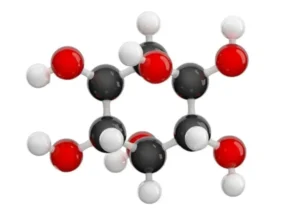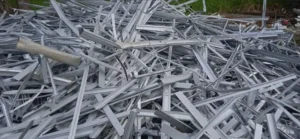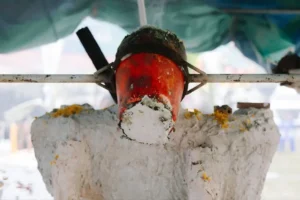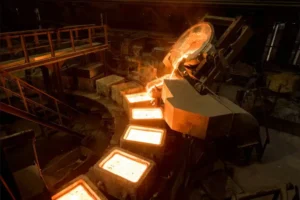Trong nhiệt độ cao, áp suất cao, và môi trường rủi ro cao của một hội thảo casting, every furnace ignition is a test of exquisite craftsmanship and rigorous operation.
Tuy nhiên, the success of a smelting shift is determined not only by advanced equipment and skilled techniques but also by the “soft skills” of communication that occur before work begins and during shift handovers.
Các “pre-shift furnace meeting” is the core vehicle for these soft skills. It acts as a bridge, connecting the experience of the previous shift with the challenges of the next.
Through effective shift handovers, clear communication of production plans, and relentless reiteration of safety points, it lays a solid foundation for the safe and efficient operation of every smelting shift.
① The Gold Standard: A Seamless Handover, các “First Leg” of Information Relay
Smelting is a highly continuous production process where any information gap can lead to production delays or even safety incidents.
Vì thế, the primary task of the pre-shift meeting is to ensure a seamless handover between shifts.
An effective handover is not just a change of personnel but a comprehensive transfer of information, responsibilities, and equipment status.
Core elements of the handover should include
- Equipment Status and Operating Parameters: How did key equipment like the melting furnace, holding furnace, and overhead crane perform during the previous shift? Were there any abnormalities? Are key parameters such as temperature, áp lực , and current within the specified ranges? Ví dụ, details like the condition of the furnace lining, the coolant flow rate for the induction coil, and the operational status of dust collection systems must be clearly communicated.
- Production Progress and Unresolved Issues: The completion status of the day’s production tasks, the remaining amount of molten metal, completed pouring tasks, and any problems encountered during production (such as fluctuations in alloy composition, inaccurate temperature readings, or slag blockages) along with their resolutions.
- Materials and Consumables: The inventory levels of remaining charge materials, hợp kim, inoculants, slag removers, and the usage and replacement status of key consumables like electrodes and thermocouples.
- Sự an toàn and Environmental Matters: Any safety hazards, near-miss incidents, or abnormalities with environmental protection equipment that occurred during the previous shift must be clearly communicated to the incoming team to raise alertness and prevent recurrence.
A standardized “Smelting Shift Handover Log” is a powerful tool for achieving a seamless handover. By combining written records with verbal confirmation, it ensures the accuracy and completeness of information, allowing the new team to grasp the full “situational awareness” of the production floor in the shortest possible time.
② The Compass: A Clear Plan, các “Roadmap” for Coordinated Action
The pre-shift meeting is the key moment for communicating and breaking down the production plan and unifying the team’s objectives. Without a clear goal, team members are like sailors navigating in the dark—not only is efficiency low, but it is also easy to go off course.
Key points for communicating the production plan
- Clarify the Day’s Tasks: Clearly convey the number of heats to be melted, the alloy grades, the tonnage of molten metal required, and the approximate pouring schedules for the shift. This ensures every employee knows, “What are we doing today, and to what standard?”
- Break Down Tasks and Assign Roles: Based on the production tasks, the shift leader must clearly assign personnel and responsibilities for each stage, including material charging, tan chảy, temperature measurement, composition adjustment, slagging, and tapping. A clear division of labor prevents errors made in haste and the shirking of responsibility.
- Emphasize Process and Quality Requirements: For different castings and alloy grades, reiterate their specific process requirements, such as melting temperature, critical timing for inoculation, and control ranges for chemical composition. This helps ensure product quality from the source.
Through communication in the pre-shift meeting, the production plan is transformed from a chart on the wall into concrete action items for each employee, enabling the entire team to operate like a well-trained army with a unified goal and coordinated action.
③ The Safety Valve: A Constant Alarm, các “Headband” for the Lifeline of Safety
In the casting workshop, “sự an toàn” is the paramount priority that overrides all else. The pre-shift meeting is the best time for routine safety education and reinforcing safety protocols. These brief ten-plus minutes can effectively awaken employees’ safety consciousness, transforming their mindset from “I am told to be safe” ĐẾN “I want to be safe.”
Best practices for reinforcing safety points
- Learning from Case Studies to Resonate with Staff: Share recent safety incident case studies from the industry or your own workshop, even minor ones. By analyzing the root causes, you allow employees to learn from others’ mistakes and viscerally understand the severe consequences of non-compliant operations.
- Emphasizing Key Risk Points: Repeatedly stress the core risks of the smelting workshop, such as molten metal splash, gas leaks, mechanical equipment injuries, high-temperature burns, and dust hazards. Ví dụ, before starting the furnace, always check that the furnace pit is dry and free of water; when lifting ladles of molten metal, personnel must stay clear of the transport path; when handling slag, full personal protective equipment (PPE) must be worn.
- Thiết bị bảo vệ cá nhân (PPE) Kiểm tra: Make it a routine part of the pre-shift meeting to check whether employees are correctly wearing their safety helmets, Khiên khuôn mặt, heat-resistant clothing, protective boots, and other PPE. This is not just an inspection but a ritualistic reminder that reinforces the habit of self-protection.
- Emergency Drill and Q&MỘT: The shift leader can randomly ask employees about the location and use of fire extinguishers, the procedure for an emergency furnace shutdown, or first-aid measures for burns. This ensures everyone knows the emergency procedures and can react correctly in a sudden situation.
Soft skills create hard power. The core of a successful pre-shift furnace meeting lies in using open, chính xác, and efficient communication to internalize the details of the shift handover, the directives of the production plan, and the rules of safe operation into the conscious actions of every employee. This is not only a matter of respect for life but is also the necessary path to elevating the management level of the casting workshop and achieving both safe production and operational excellence.
When every pre-shift meeting achieves informational transparency, clear objectives, and constant vigilance, every furnace fire in the workshop will burn more safely, stably, and efficiently.







